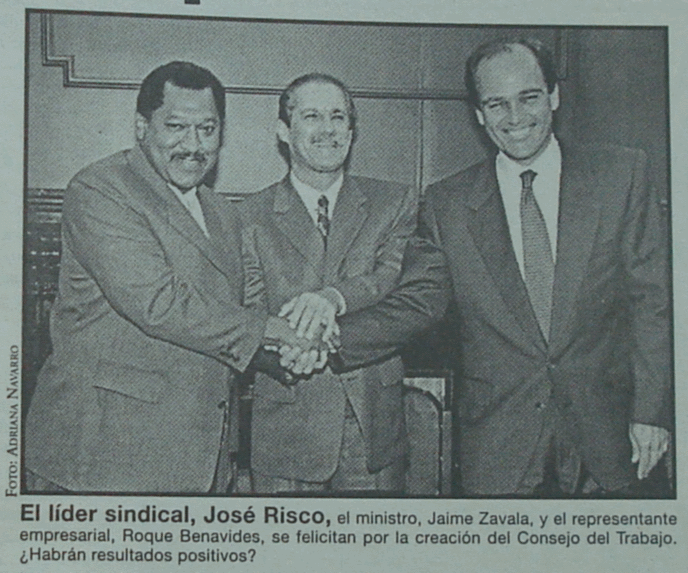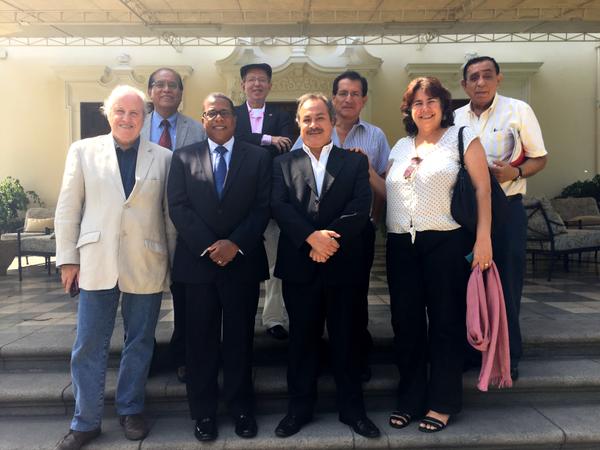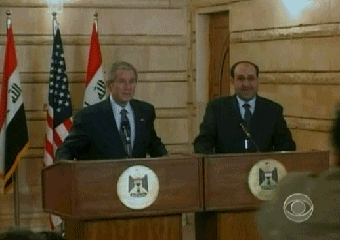Por GRAN COMBO CLUB - Publicado el 13-03-2015
Los actuales dirigentes de la CGTP también están entre los informantes de la embajada de los Estados Unidos, como señalamos aquí.
El Comercio en marzo de 2011, cuando los Wikicables fueron exclusivamente proporcionado a este diario en el Perú, seleccionó un cable, ver aquí, desde su particular punto de vista. Sin embargo, sólo con la publicación general de Wikicables es que se puede tener un panorama más completo sobre las reuniones de los actuales dirigentes de la CGTP, y el SUTEP, con los funcionarios de la embajada de los EEUU.
En estas reuniones los dirigentes sindicales les cuentan a los oficiales políticos de la embajada sobre temas internos del sindicalismo como temas políticos de la izquierda peruana: sus estrategias, sus tácticas, todo es compartido abiertamente con la embajada de los Estados Unidos.
Este Wikicable de 2007 muestra a los dirigentes de la CGTP contándole al oficial político de la embajada de los EEUU sobre líos internos del sindicalismo peruano: el apoyo a los mineros de Casapalca o las contradicciones en el seno del SUTEP.
Los dirigentes de la CGTP le cuentan al Poloff (Political Officer, Oficial Político) que “se sienten obligados” a apoyar al SUTEP.
Inadmisible.
Lo que la embajada quiere saber como prioridad es si la protestas sindicales van a ser de corto o de largo aliento, una información táctica importante, pues los inversionistas temen que las protestas se conviertan en un movimiento nacional. Los dirigentes de la CGTP no tienen problemas con darle la información a la embajada y ésta concluye que las protestas serán de corto aliento.
(También el entonces premier Jorge Del Castillo y la “defensora del pueblo” Beatriz Merino se confiesan con el embajador, pero eso ya no es novedad).
Huamán incluso le pide a la embajada que presione al gobierno peruano para que se cumpla con la protección laboral (y la embajada contesta que lleven ese pedido a las autoridades peruanas electas).
Al final, la embajada concluye, en base a lo que declara el gobierno y los sindicatos, que la mejor protección laboral es el APTDA, que finalmente sería el TLC. (Como sabemos, esto no ha ocurrido).
Y no sólo dirigentes de la CGTP, sino también del SUTEP son informantes de la embajada, contándole al Oficial Político sobre las estrategias políticas de los partidos de izquierda, si aliarse con Humala, si aliarse con Paniagua, sobre si el Frente Amplio se alía con el Partido Democrático Descentralista de Javier Diez Canseco. A la embajada le preocupaba que la izquierda sumara sus fuerzas para apoyar a Humala en el 2006 y evalúa, en septiembre de 2005, que Humala puede llegar a tener entre un 15 y 20% de los votos.



Sindicalistas Mario Huaman, Juan José Gorriti, Nilver López en reuniones con funcionarios de embajada de los Estados Unidos según revela Wikileaks. Les cuentan muchas cosas. ¿Informaron a sus bases sindicales sobre estas reuniones?
Imágenes tomadas de aquí, aquí, y aquí.

2011. José Luis Risco por la CGTP, Jorge Benavides por la CONFIEP y Jaime Zavala por el gobierno. Después de la caída del fujimorismo los dirigentes de la CGTP se dedicaron a conformar instancias creadas por el gobierno, sin conseguir nada para los trabajadores. Llegaron incluso a reunirse con funcionarios de la embajada de los Estados Unidos, contándoles sobre temas internos del sindicalismo peruano, y tampoco consiguieron nada. Ahí están los Wikicables, contando sobre estas reuniones.
Imagen tomada de aquí. (Pocos días después de este evento el dirigente de la CGTP saldría del clóset político integrando la lista de la candidata derechista Lourdes Flores como candidato a la vicepresidencia (puesto que antes habría sido ofrecido al izquierdista Carlos Tapia). Posteriormente Risco seguiría haciendo carrera política junto a Alex Khoury y a Fernando Altuve en “Cambio Radical”. Nadie se derechiza de la noche a la mañana. Es claro que este señor ya se había volteado cuando fungía de representante de los trabajadores, desde luego perjudicándolos. En su sentada en el CNT (al igual que en la conducción de la CGTP en los 90s) Risco sería secundado por otros dirigentes como Juan José Gorriti y Mario Huamán.)
Actualización: Hace unos días nomás el embajador de los EEUU se reunió con “líderes laborales” (?). Dado que la CGTP se ha “oenegeizado”, ahora se reúne directamente con las ONGs que la digitan.
Javier Neves, Javier Mujica, Giovanna Larco y otros.

“Embajador Nichols se reunio hoy con lideres laborales para hablar sobre como Peru y EEUU trabajan juntos en este tema ”
https://twitter.com/USEMBASSYPERU/status/572883741124636674
Fuente: http://grancomboclub.com/2015/03/los-dirigentes-de-la-cgtp-con-el-poloff-de-la-embajada-de-los-eeuu.html
-
El Comercio en marzo de 2011, cuando los Wikicables fueron exclusivamente proporcionado a este diario en el Perú, seleccionó un cable, ver aquí, desde su particular punto de vista. Sin embargo, sólo con la publicación general de Wikicables es que se puede tener un panorama más completo sobre las reuniones de los actuales dirigentes de la CGTP, y el SUTEP, con los funcionarios de la embajada de los EEUU.
En estas reuniones los dirigentes sindicales les cuentan a los oficiales políticos de la embajada sobre temas internos del sindicalismo como temas políticos de la izquierda peruana: sus estrategias, sus tácticas, todo es compartido abiertamente con la embajada de los Estados Unidos.
Este Wikicable de 2007 muestra a los dirigentes de la CGTP contándole al oficial político de la embajada de los EEUU sobre líos internos del sindicalismo peruano: el apoyo a los mineros de Casapalca o las contradicciones en el seno del SUTEP.
Los dirigentes de la CGTP le cuentan al Poloff (Political Officer, Oficial Político) que “se sienten obligados” a apoyar al SUTEP.
Inadmisible.
Lo que la embajada quiere saber como prioridad es si la protestas sindicales van a ser de corto o de largo aliento, una información táctica importante, pues los inversionistas temen que las protestas se conviertan en un movimiento nacional. Los dirigentes de la CGTP no tienen problemas con darle la información a la embajada y ésta concluye que las protestas serán de corto aliento.
(También el entonces premier Jorge Del Castillo y la “defensora del pueblo” Beatriz Merino se confiesan con el embajador, pero eso ya no es novedad).
CGTP sources told poloff that the union had been caught off guard by Minister of Labor Pinella’s quick action in meeting with Casapalca miners and by the GOP’s willingness to support the miner’s demands, but decided to go ahead with the march anyway. Prime Minister Jorge del Castillo told the Ambassador July 9 that he expected the CGTP would be unable to maintain the strike.Los líderes sindicales no ponen el énfasis en el cambio de las leyes laborales o defienden la Ley General del Trabajo, sino que declaran que el problema no es que falten leyes laborales para proteger al trabajador, sino que las que existen no se cumplen.
(…)
4. (SBU) The far-left teacher’s union SUTEP (the United Syndicate of Peruvian Educational Workers) continued an indefinite strike, now in its third week, that was supported by the CGTP. SUTEP protests took place throughout Peru, and more than 3,000 teachers marched in the province of Tumbes. The teachers have received widespread condemnation in the Lima press, and most schools have continued classes without interruption. CGTP leaders told poloff they felt obliged to support a besieged union, but at the same time, they admit an internal power struggle has broken out within SUTEP, with a regional faction lead by Robert Huayanlaya — who reportedly has ties to terrorists — seeking a more confrontational approach with the government.
(…)
10. (SBU) But the protest cycle could resume in August, and images of loud, threatening demonstrations taking place throughout Peru carry a cost. The protests have put international investors on edge, and popular mobilizations provide extremists the opportunity over time to turn local discontent into a national movement. No evidence has emerged of overall coordination or management of the protests, but the danger exists that simmering discontent could flare at any time into popular outrage. End Comment. STRUBLE
PERU FACES A “TORNADO OF PROTESTS”
Date: 2007 July 13, 16:48 (Friday)
Huamán incluso le pide a la embajada que presione al gobierno peruano para que se cumpla con la protección laboral (y la embajada contesta que lleven ese pedido a las autoridades peruanas electas).
Al final, la embajada concluye, en base a lo que declara el gobierno y los sindicatos, que la mejor protección laboral es el APTDA, que finalmente sería el TLC. (Como sabemos, esto no ha ocurrido).
7. (C) Union leaders say the real problem in Peru is not a lack of legislation but the failure of the government to enforce existing labor laws. In separate interviews with poloffs, the heads of Peru’s four major labor confederations said the PTPA offers the best hope of forcing the GOP to put teeth into enforcement and to end practices such as the illegal use of contract workers that have swelled the ranks of informal workers. Each confederation has formed a committee to monitor the GOP’s compliance with what they understand as the PTPA’s provisions. Huaman, for example, says the CGTP can document 3448 cases in the past year when CGTP organizers were fired for engaging in union activity. Huaman says he will encourage the Embassy to press for GOP enforcement of labor protections. Other unions have similar intentions. (Note: In discussions with contacts in organized labor, we often underscore the utility of their taking their case directly to Peruvian government and elected authorities. End Note.)Y para que no queden dudas, es el mismo Mario Huamán quien está en reuniones con el Poloff (Oficial Político) de la embajada:
UNIONS LOOK AT THE PERUVIAN LABOR SCENE
Date: 2008 March 14, 21:19 (Friday)
“2. (C) In separate meetings with poloffs, labor and government officials gave conflicting estimates of the number of Peruvians working in the informal economy. Mario Huaman, secretary general of Peru’s largest labor confederation — the pro-Communist General Confederation of Peruvian Workers (CGTP) — said 75 per cent of Peruvians workers, eight million workers in an 11 million-member labor force, lack formal employment.”El resultado de todo esto es que chotean a Huaman.
UNIONS LOOK AT THE PERUVIAN LABOR SCENE
Date: 2008 March 14, 21:19 (Friday)
Y no sólo dirigentes de la CGTP, sino también del SUTEP son informantes de la embajada, contándole al Oficial Político sobre las estrategias políticas de los partidos de izquierda, si aliarse con Humala, si aliarse con Paniagua, sobre si el Frente Amplio se alía con el Partido Democrático Descentralista de Javier Diez Canseco. A la embajada le preocupaba que la izquierda sumara sus fuerzas para apoyar a Humala en el 2006 y evalúa, en septiembre de 2005, que Humala puede llegar a tener entre un 15 y 20% de los votos.
“Poloff interviewed SUTEP International Relations Secretary (and former SUTEP President) Nilver Lopez, SUTEP President Caridad Montes, and CGTP Secretary General Juan Jose Gorritti on 9/13 regarding the status of the Frente Amplio.
(…)
3. (C) According to SUTEP’s Nilver Lopez, the Frente Amplio will support Ollanta Humala’s presidential bid. Ollanta and his brother Antauro led a military rebellion against the Fujimori regime in 2000.
(…)
4. (C) SUTEP’s Lopez said the Frente Amplio would have preferred to cement an electoral alliance with Congressman Javier Diaz Canseco and his Decentralized Democratic Party (PDD), but Diaz Canseco, in Lopez’ words, “wants to ally with Paniagua” as part of a leftist/centrist front. Consequently, the Frente Amplio shifted its gaze to Ollanta Humala, hoping that Ollanta’s ultra-nationalism will help them surmount their image as discredited old-line leftists. With Ollanta as their front man, Lopez continued, the Frente Amplio could score between 10 and 15 percent of the vote and thereby gain a base in the next Congress.
(…)
7. (C) CGTP Secretary General Juan Jose Gorritti signaled the direction for the Frente Amplio in a conversation with Poloff on 9/13. Gorritti said that the Frente would take up “national defense” issues like port privatization, stressing the risk that Chilean investors might seize control of Peru’s docks and loading areas. SUTEP’s Nilver Lopez put the point even more bluntly. When questioned about some of the non-leftist elements in the Humala family’s Ethno-Cacerista ideology, Lopez replied that the hard left needed to use nationalism if it was to successfully project its social justice message. Lopez told Poloff that even with Ollanta at the top of the ticket, people who understand “the class struggle” would run the campaign. In the end, the ideological differences didn’t matter to Lopez, since the Marxists’ goal in 2006 is not/not to win the presidency, but rather to score 10-15 percent of the vote and place a sizable bloc of their members in Congress.
FAR LEFT, INSPIRED BY CHAVEZ, SEEKING TO RIDE OLLANTA HUMALA’S COAT-TAILS INTO CONGRESS
Date: 2005 September 22, 19:23



Sindicalistas Mario Huaman, Juan José Gorriti, Nilver López en reuniones con funcionarios de embajada de los Estados Unidos según revela Wikileaks. Les cuentan muchas cosas. ¿Informaron a sus bases sindicales sobre estas reuniones?
Imágenes tomadas de aquí, aquí, y aquí.

2011. José Luis Risco por la CGTP, Jorge Benavides por la CONFIEP y Jaime Zavala por el gobierno. Después de la caída del fujimorismo los dirigentes de la CGTP se dedicaron a conformar instancias creadas por el gobierno, sin conseguir nada para los trabajadores. Llegaron incluso a reunirse con funcionarios de la embajada de los Estados Unidos, contándoles sobre temas internos del sindicalismo peruano, y tampoco consiguieron nada. Ahí están los Wikicables, contando sobre estas reuniones.
Imagen tomada de aquí. (Pocos días después de este evento el dirigente de la CGTP saldría del clóset político integrando la lista de la candidata derechista Lourdes Flores como candidato a la vicepresidencia (puesto que antes habría sido ofrecido al izquierdista Carlos Tapia). Posteriormente Risco seguiría haciendo carrera política junto a Alex Khoury y a Fernando Altuve en “Cambio Radical”. Nadie se derechiza de la noche a la mañana. Es claro que este señor ya se había volteado cuando fungía de representante de los trabajadores, desde luego perjudicándolos. En su sentada en el CNT (al igual que en la conducción de la CGTP en los 90s) Risco sería secundado por otros dirigentes como Juan José Gorriti y Mario Huamán.)
Actualización: Hace unos días nomás el embajador de los EEUU se reunió con “líderes laborales” (?). Dado que la CGTP se ha “oenegeizado”, ahora se reúne directamente con las ONGs que la digitan.
Javier Neves, Javier Mujica, Giovanna Larco y otros.

“Embajador Nichols se reunio hoy con lideres laborales para hablar sobre como Peru y EEUU trabajan juntos en este tema ”
https://twitter.com/USEMBASSYPERU/status/572883741124636674
Fuente: http://grancomboclub.com/2015/03/los-dirigentes-de-la-cgtp-con-el-poloff-de-la-embajada-de-los-eeuu.html






















No hay comentarios:
Publicar un comentario